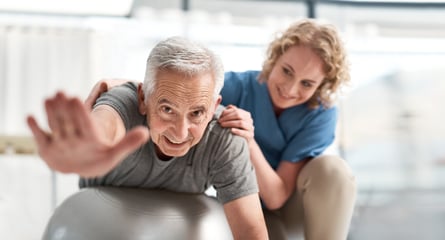 Improving balance can be tricky. Where do we start? What even is balance training? Standing on one leg? Walking more? It seems like everyone has their own idea of balance. What we do know, is that it becomes more important for active older adults to build and maintain balance with each passing year.
Improving balance can be tricky. Where do we start? What even is balance training? Standing on one leg? Walking more? It seems like everyone has their own idea of balance. What we do know, is that it becomes more important for active older adults to build and maintain balance with each passing year.
All of these can certainly help our balance! But a method that has seen success is building strength, endurance, and balance from the ground up. It makes sense after all. Our feet are the only part of our bodies in direct contact with the ground as we walk. It stands to reason that strengthening the foot, ankle, and muscles of the lower legs would be helpful.
We have been incorporating lower leg and foot/ankle exercises for the past year but two of the most practical ones (in my experience) have been the short foot drill (invented by Dr. Vladimir Janda) and the tibialis raise (popularized by Ben Patrick the “knees over toes guy”).
The short foot drill can be complicated to learn and teach but I have found it to be highly beneficial for seniors. It might take a few extra minutes to explain the nuances of the drill but once they have their “lightbulb moment” this drill can be beneficial for essentially any standing movement one encounters. The idea is to spread the toes wide to widen the base of the foot. Try and find the “foot tripod”. This means the 1st metatarsal (by the big toe), the 5th metatarsal (by the pinky toe) and the heel. Then gently (think 20% effort) press the tips of the toes into the ground until the 1st metatarsal head lifts up.
This movement can be further complicated, but I find that this is a good starting point for most people. This movement trains the intrinsic foot muscles which are responsible for building and maintaining the arch of the foot. For those who have flat feet or collapsed arches, this can be an essential movement.
While some residents are still in the process of learning the short foot drill, the ones who have “got it” speak about the benefits. They have noted that it applies to standing exercises as well as balance and stability while walking and standing throughout the days. Some have said it has lessened their knee pain. My personal favorite bit of feedback was from one of our most consistent class attendees who said the short foot drill felt like it was “waking up” her feet and legs. I think it is a very important drill to put time into learning and teaching.
The tibialis raise is (fortunately) a good deal easier to teach and explain. While the typical version is performed standing, I almost always use a modified seated version with our senior fitness classes.
The basic concept behind tibialis raises is to strengthen the often neglected and underdeveloped anterior tibialis muscle. This muscle is responsible for “dorsiflexing” the foot which is a technical term for saying “this muscle lifts the foot up”. When practicing this exercise, I instruct our residents to put their fingers on the tibialis anterior muscle so they can feel it contract as they lift the front of their feet upwards. This has been the most useful method for allowing them to feel the muscle contract. Activating and strengthening this muscle seems to have a positive effect on knee and ankle healthy. The tibialis anterior can be thought of as one of the “braking” muscles of the lower body. When one is walking or changing direction, some of the forces from the ground should be absorbed by the tibialis anterior. When this muscle is weak or inactive that can lead to extra forces irritating the knees or ankles. Having strong and healthy tibialis anterior muscles can protect the legs and increase balance.
As for results, well it depends. There isn’t an exact way to track how effective these exercises are. As mentioned, I have heard great feedback from my residents. When it comes to balance, I think incorporating these two exercises to strengthen and activate the feet and lower legs as part of a comprehensive exercise plan can be highly beneficial to almost anyone.

